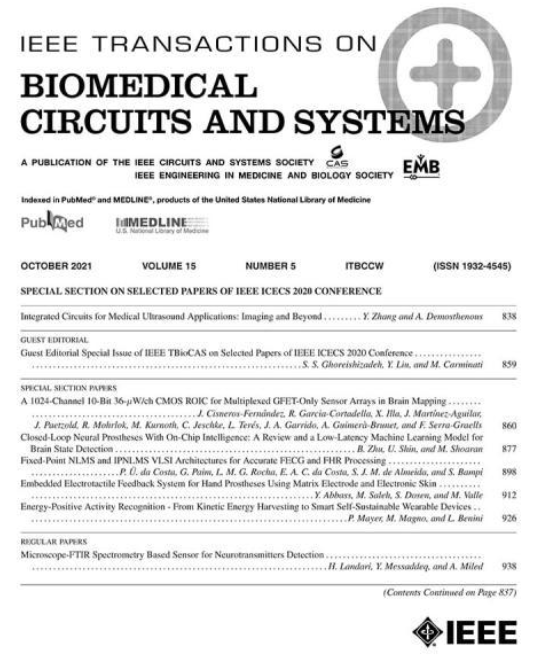基于纸基微流体与自组装快速响应码集成的自供电前向纠错生物传感器。
IF 4.9
2区 医学
Q2 ENGINEERING, BIOMEDICAL
IEEE Transactions on Biomedical Circuits and Systems
Pub Date : 2016-10-01
DOI:10.1109/TBCAS.2016.2580156
引用次数: 3
摘要
本文扩展了我们之前基于银增强的自组装结构的工作,用于设计可靠的、具有前向纠错(FEC)能力的自供电生物传感器。该方法的核心是将基于纸张的微流体与可使用智能手机进行光学扫描的快速响应(QR)码相结合。扫描的信息首先被解码以获得网络服务器的位置,该服务器进一步处理自组装的QR图像以确定目标分析物的浓度。所提出的FEC生物传感器的集成基板是聚乙烯,基板上的QR码图案已经使用低成本喷墨打印和常规圆珠笔的组合实现。在基板下方集成了一个基于纸张的微流体通道,用于获取、混合和将样品流动到基板上的区域,在这些区域中,代码的不同部分可以在固定金纳米棒的存在下自组装。在本文中,我们演示了使用QR编码FEC生物传感器原型的概念验证检测。本文章由计算机程序翻译,如有差异,请以英文原文为准。
Self-Powered Forward Error-Correcting Biosensor Based on Integration of Paper-Based Microfluidics and Self-Assembled Quick Response Codes.
This paper extends our previous work on silver-enhancement based self-assembling structures for designing reliable, self-powered biosensors with forward error correcting (FEC) capability. At the core of the proposed approach is the integration of paper-based microfluidics with quick response (QR) codes that can be optically scanned using a smart-phone. The scanned information is first decoded to obtain the location of a web-server which further processes the self-assembled QR image to determine the concentration of target analytes. The integration substrate for the proposed FEC biosensor is polyethylene and the patterning of the QR code on the substrate has been achieved using a combination of low-cost ink-jet printing and a regular ballpoint dispensing pen. A paper-based microfluidics channel has been integrated underneath the substrate for acquiring, mixing and flowing the sample to areas on the substrate where different parts of the code can self-assemble in presence of immobilized gold nanorods. In this paper we demonstrate the proof-of-concept detection using prototypes of QR encoded FEC biosensors.
求助全文
通过发布文献求助,成功后即可免费获取论文全文。
去求助
来源期刊

IEEE Transactions on Biomedical Circuits and Systems
工程技术-工程:电子与电气
CiteScore
10.00
自引率
13.70%
发文量
174
审稿时长
3 months
期刊介绍:
The IEEE Transactions on Biomedical Circuits and Systems addresses areas at the crossroads of Circuits and Systems and Life Sciences. The main emphasis is on microelectronic issues in a wide range of applications found in life sciences, physical sciences and engineering. The primary goal of the journal is to bridge the unique scientific and technical activities of the Circuits and Systems Society to a wide variety of related areas such as: • Bioelectronics • Implantable and wearable electronics like cochlear and retinal prosthesis, motor control, etc. • Biotechnology sensor circuits, integrated systems, and networks • Micropower imaging technology • BioMEMS • Lab-on-chip Bio-nanotechnology • Organic Semiconductors • Biomedical Engineering • Genomics and Proteomics • Neuromorphic Engineering • Smart sensors • Low power micro- and nanoelectronics • Mixed-mode system-on-chip • Wireless technology • Gene circuits and molecular circuits • System biology • Brain science and engineering: such as neuro-informatics, neural prosthesis, cognitive engineering, brain computer interface • Healthcare: information technology for biomedical, epidemiology, and other related life science applications. General, theoretical, and application-oriented papers in the abovementioned technical areas with a Circuits and Systems perspective are encouraged to publish in TBioCAS. Of special interest are biomedical-oriented papers with a Circuits and Systems angle.
 求助内容:
求助内容: 应助结果提醒方式:
应助结果提醒方式:


